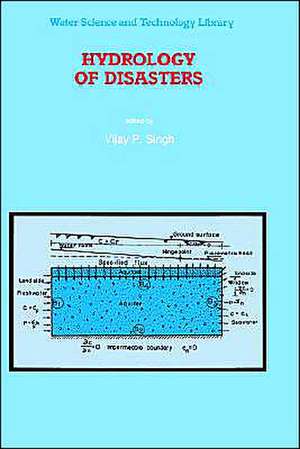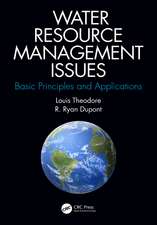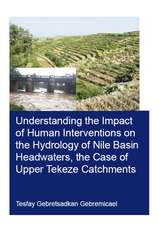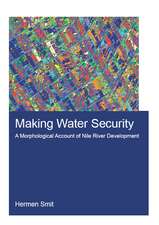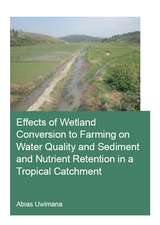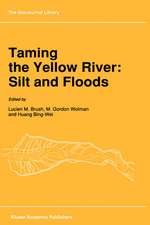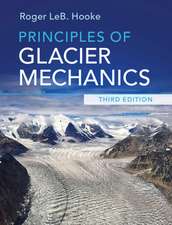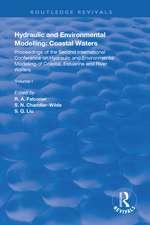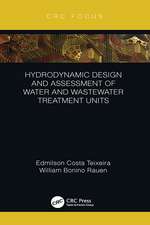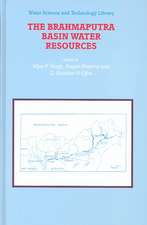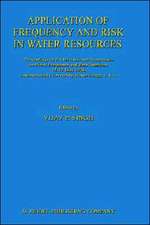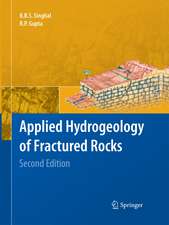Hydrology of Disasters: Water Science and Technology Library, cartea 24
Editat de V. P. Singhen Limba Engleză Hardback – 31 iul 1996
| Toate formatele și edițiile | Preț | Express |
|---|---|---|
| Paperback (1) | 952.26 lei 6-8 săpt. | |
| SPRINGER NETHERLANDS – 15 dec 2010 | 952.26 lei 6-8 săpt. | |
| Hardback (1) | 958.38 lei 6-8 săpt. | |
| SPRINGER NETHERLANDS – 31 iul 1996 | 958.38 lei 6-8 săpt. |
Din seria Water Science and Technology Library
- 18%
 Preț: 950.96 lei
Preț: 950.96 lei - 15%
 Preț: 646.62 lei
Preț: 646.62 lei - 24%
 Preț: 796.92 lei
Preț: 796.92 lei - 18%
 Preț: 892.90 lei
Preț: 892.90 lei - 18%
 Preț: 953.65 lei
Preț: 953.65 lei -
 Preț: 459.43 lei
Preț: 459.43 lei - 18%
 Preț: 742.31 lei
Preț: 742.31 lei - 18%
 Preț: 1226.11 lei
Preț: 1226.11 lei - 18%
 Preț: 956.50 lei
Preț: 956.50 lei - 18%
 Preț: 1225.48 lei
Preț: 1225.48 lei - 18%
 Preț: 776.40 lei
Preț: 776.40 lei - 18%
 Preț: 1014.76 lei
Preț: 1014.76 lei - 18%
 Preț: 957.13 lei
Preț: 957.13 lei - 24%
 Preț: 744.68 lei
Preț: 744.68 lei - 18%
 Preț: 953.35 lei
Preț: 953.35 lei - 18%
 Preț: 1108.04 lei
Preț: 1108.04 lei - 18%
 Preț: 1121.65 lei
Preț: 1121.65 lei - 15%
 Preț: 644.63 lei
Preț: 644.63 lei - 18%
 Preț: 1116.71 lei
Preț: 1116.71 lei - 18%
 Preț: 731.91 lei
Preț: 731.91 lei - 24%
 Preț: 744.33 lei
Preț: 744.33 lei - 18%
 Preț: 894.46 lei
Preț: 894.46 lei - 18%
 Preț: 1020.74 lei
Preț: 1020.74 lei - 24%
 Preț: 945.42 lei
Preț: 945.42 lei -
 Preț: 553.51 lei
Preț: 553.51 lei - 24%
 Preț: 840.38 lei
Preț: 840.38 lei
Preț: 958.38 lei
Preț vechi: 1168.76 lei
-18% Nou
Puncte Express: 1438
Preț estimativ în valută:
183.41€ • 199.15$ • 154.06£
183.41€ • 199.15$ • 154.06£
Carte tipărită la comandă
Livrare economică 22 aprilie-06 mai
Preluare comenzi: 021 569.72.76
Specificații
ISBN-13: 9780792340928
ISBN-10: 0792340922
Pagini: 442
Ilustrații: XIV, 442 p.
Dimensiuni: 156 x 234 x 25 mm
Greutate: 0.82 kg
Ediția:1996
Editura: SPRINGER NETHERLANDS
Colecția Springer
Seria Water Science and Technology Library
Locul publicării:Dordrecht, Netherlands
ISBN-10: 0792340922
Pagini: 442
Ilustrații: XIV, 442 p.
Dimensiuni: 156 x 234 x 25 mm
Greutate: 0.82 kg
Ediția:1996
Editura: SPRINGER NETHERLANDS
Colecția Springer
Seria Water Science and Technology Library
Locul publicării:Dordrecht, Netherlands
Public țintă
ResearchCuprins
1 Disasters: Natural or Man-made.- 1.1 Types of Disasters.- 1.2 Environmental and Hydrologic Consequences.- 1.3 Mitigation of Disasters.- 2 Representativity of Extreme Wind Data.- 2.1 Introduction.- 2.2 Wind phenomena Classified by the Wind Sspectrum.- 2.3 What Are Representative Wind Data?.- 2.4 Representativity of “Potential Wind”.- 2.5 Roughness Determination at Ordinary Wind Stations.- 2.6 Scale of Application of Station-Observed Wind.- 2.7 Getting and Using Potential Wind Data.- 2.8 Distribution of Average Wind Speeds.- 2.9 Shelter Problems in Analysis of Extreme Stormwind speeds.- 2.10 Some Available Studies of Extreme wind Speeds.- 3 Climate Change and Hydrological Disasters.- 3.1 Introduction.- 3.2 The Greenhouse Effect, Climate Change and Hydrological Regimes.- 3.3 Estimating the Impacts of Climate Change on Hydrological Characteristics.- 3.4 Impacts of Climate Change on Floods.- 3.5 Impact of Climate Change on Drought.- 3.6 Conclusions.- 4 Extreme Floods.- 4.1 Introduction.- 4.2 Limitations of Statistical Methods for Estimating Design Floods.- 4.3 Data Series Used in the Estimation of Design Floods.- 4.4 Flood “Quantiles” as Design Events.- 4.5 Statistical Hypotheses Used for Estimating Design Floods.- 4.6 Some Remarks Pertaining to Flood Data.- 4.7 Choice of “D / E Procedure” for Flood Frequency Analysis.- 4.8 Regional Flood Frequency Estimation.- 4.9 Conclusions.- 5 Dam-Breach Floods.- 5.1 Introduction.- 5.2 Breach Description.- 5.3 Dam-Breach Flood Routing.- 5.4 Dam-Breach Flood Routing Data.- 5.5 Teton Dam-Breach Flood Case Study.- 5.6 Uncertainties of Dam-Breach Flood Modeling.- 6 Extreme Droughts.- 6.1 Introduction.- 6.2 Physical Systems Involved in a Drought.- 6.3 The Evolution of Extreme Drought.- 6.4 Modeling an Extreme Drought.- 6.5Discussion and Conclusions.- 7 Mud and Debris Flows.- 7.1 Introduction.- 7.2 Physical Processes.- 7.3 Methods of Prediction: When, Where, and How Much.- 7.4 Debris Flow Mitigation.- 7.5 Statistical Modeling of Debris Flows.- 7.6 Conclusions.- 8 Landslides.- 8.1 Introduction.- 8.2 Hydrological Triggering Mechanisms.- 8.3 Rainfall and Landslide Disasters.- 8.4 Regional Groundwater Flow.- 8.5 First-time and reactivated landslides.- 8.6 First-time Translational Slides.- 8.7 First-Time Rotational and Complex Deep-Seated Pre-Existing Landslide Movements.- 8.8 Landslide Caprocks and Their Response to Rainfall.- 8.9 Groundwater Models, Pre-Existing Landslide Complexes and Regional Planning.- 8.10 Landslides Associated with Snowmelt, Permafrost and Glaciers.- 8.11 Erosion, Rivers and Landslides.- 8.12 Storm-Induced Submarine Landslides.- 8.13 Conclusions.- 9 Land Subsidence.- 9.1 Introduction.- 9.2 Review of Mathematical Theory of Land Subsidence due to Fluid Withdrawal.- 9.3 Illustrative Case Studies.- 10 Saltwater Intrusion.- 10.1 Hydrological Aspects.- 10.2 Sharp Interface and Density Dependent Approaches.- 10.3 Dispersion in Porous Media.- 10.4 Mechanism of Saltwater Intrusion into Coastal Aquifers.- 10.5 Governing Equations.- 10.6 Initial and Boundary Conditions.- 10.7 Numerical Methods.- 10.8 Finite Element Formulation for Density Dependent Problems.- 10.9 Study Cases.- 10.10Concluding Remarks.- 11 Avalanche Dynamics.- 11.1 Introduction.- 11.2 Some Distinctive Characteristics of Granular Flows.- 11.3 One-Dimensional Model.- 11.4 Two-Dimensional Unconfined Flow.- 11.5 Density and Turbidity Current Concept.- 11.6 Two-phase Flow Models.- 11.7 Concluding remarks.- 12 Hydrological Disasters Associated with Volcanoes.- 12.1 Introduction.- 12.2 Steam (Phreatic) Explosions.- 12.3Eruptions Through a Crater Lake.- 12.4 Pyroclastic Flows Interacting with Water.- 12.5 Volcanic Melting of Snow and Ice.- 12.6 Volcanogenic Tsunamis.- 12.7 Release of Gases from a Crater Lake.- 12.8 Non-Volcanic Initiated Collapse of a Crater Lake.- 12.9 Heavy Rains on Recently Erupted Materials.- 12.10Conclusion.- 13 Earthquakes.- 13.1 Introduction.- 13.2 Example of Hydrologic Consequences of Earthquakes.- List of Contributors.
